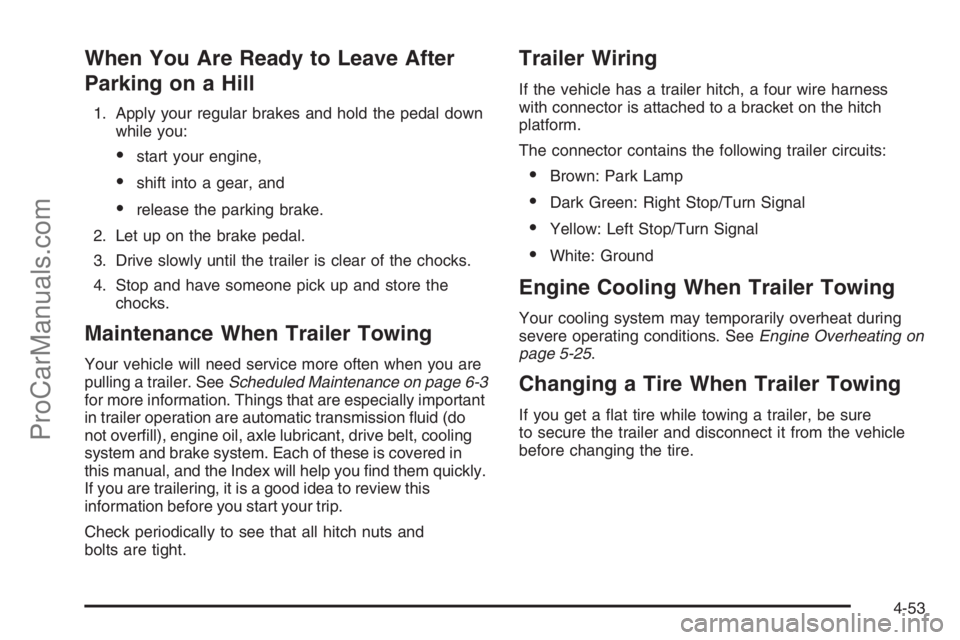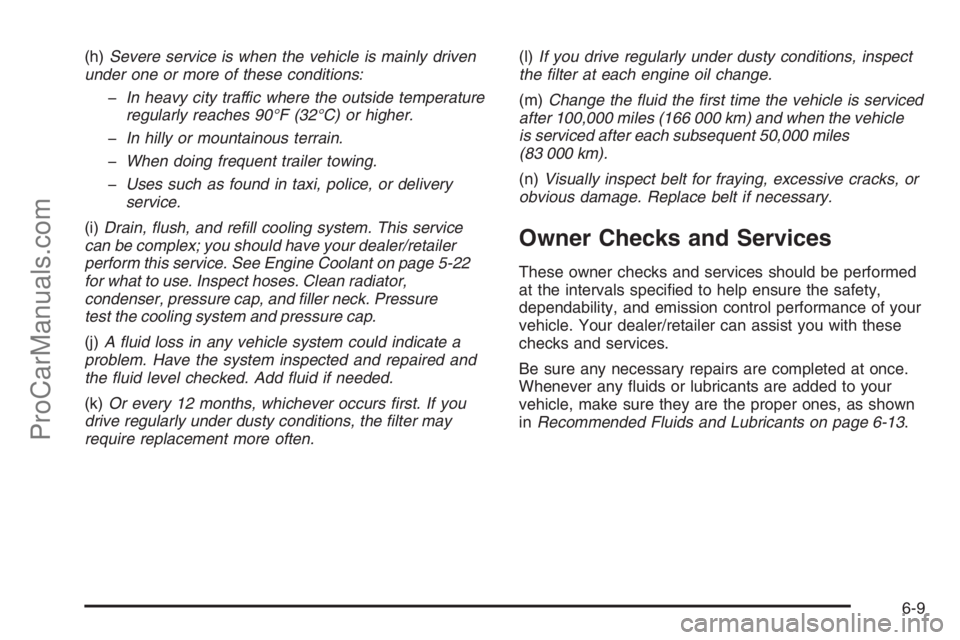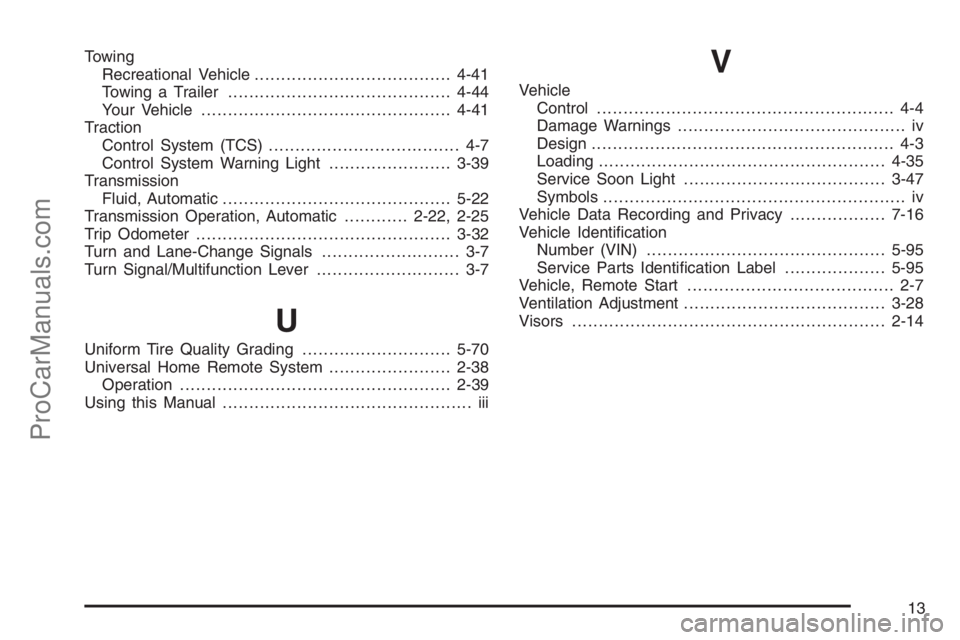towing SATURN VUE 2008 Owner's Manual
[x] Cancel search | Manufacturer: SATURN, Model Year: 2008, Model line: VUE, Model: SATURN VUE 2008Pages: 412, PDF Size: 2.78 MB
Page 251 of 412

Following Distance
Stay at least twice as far behind the vehicle ahead as
you would when driving your vehicle without a trailer.
This can help you avoid situations that require
heavy braking and sudden turns.
Passing
You will need more passing distance up ahead when
you are towing a trailer. And, because you are a
good deal longer when towing a trailer, you will need
to go much farther beyond the passed vehicle
before you can return to your lane.
Backing Up
Hold the bottom of the steering wheel with one hand.
Then, to move the trailer to the left, just move that hand
to the left. To move the trailer to the right, move your
hand to the right. Always back up slowly and, if possible,
have someone guide you.
Making Turns
Notice:Making very sharp turns while trailering
could cause the trailer to come in contact with
the vehicle. Your vehicle could be damaged.
Avoid making very sharp turns while trailering.
When you are turning with a trailer, make wider turns
than normal. Do this so your trailer will not strike
soft shoulders, curbs, road signs, trees or other objects.
Avoid jerky or sudden maneuvers. Signal well in
advance.
Turn Signals When Towing a Trailer
When you tow a trailer, your vehicle may need a
different turn signal �asher and/or extra wiring. See your
dealer/retailer if you need information. The arrows on
your instrument panel will �ash whenever you signal a
turn or lane change. Properly hooked up, the trailer lamps
will also �ash, telling other drivers you are about to turn,
change lanes or stop.
When towing a trailer, the arrows on your instrument
panel will �ash for turns even if the bulbs on the trailer
are burned out. Thus, you may think drivers behind
you are seeing your signal when they are not. It
is important to check occasionally to be sure the
trailer bulbs are still working.
4-51
ProCarManuals.com
Page 253 of 412

When You Are Ready to Leave After
Parking on a Hill
1. Apply your regular brakes and hold the pedal down
while you:
start your engine,
shift into a gear, and
release the parking brake.
2. Let up on the brake pedal.
3. Drive slowly until the trailer is clear of the chocks.
4. Stop and have someone pick up and store the
chocks.
Maintenance When Trailer Towing
Your vehicle will need service more often when you are
pulling a trailer. SeeScheduled Maintenance on page 6-3
for more information. Things that are especially important
in trailer operation are automatic transmission �uid (do
not over�ll), engine oil, axle lubricant, drive belt, cooling
system and brake system. Each of these is covered in
this manual, and the Index will help you �nd them quickly.
If you are trailering, it is a good idea to review this
information before you start your trip.
Check periodically to see that all hitch nuts and
bolts are tight.
Trailer Wiring
If the vehicle has a trailer hitch, a four wire harness
with connector is attached to a bracket on the hitch
platform.
The connector contains the following trailer circuits:
Brown: Park Lamp
Dark Green: Right Stop/Turn Signal
Yellow: Left Stop/Turn Signal
White: Ground
Engine Cooling When Trailer Towing
Your cooling system may temporarily overheat during
severe operating conditions. SeeEngine Overheating on
page 5-25.
Changing a Tire When Trailer Towing
If you get a �at tire while towing a trailer, be sure
to secure the trailer and disconnect it from the vehicle
before changing the tire.
4-53
ProCarManuals.com
Page 260 of 412

Gasoline Octane
If your vehicle has the 2.4L L4 engine (VIN Code P) or
the 3.5L V6 engine (VIN Code N), use regular unleaded
gasoline with a posted octane rating of 87 or higher. If the
octane rating is less than 87, you might notice an audible
knocking noise when you drive, commonly referred to as
spark knock. If this occurs, use a gasoline rated at 87
octane or higher as soon as possible. If you are using
gasoline rated at 87 octane or higher and you hear heavy
knocking, the engine needs service.
If your vehicle has the 3.6L V6 engine (VIN Code 7),
use regular unleaded gasoline with a posted octane
rating of 87 or higher. For best performance or trailer
towing, you could choose to use middle grade 89 octane
unleaded gasoline. If the octane rating is less than 87,
you might notice an audible knocking noise when you
drive, commonly referred to as spark knock. If this occurs,
use a gasoline rated at 87 octane or higher as soon as
possible. If you are using gasoline rated at 87 octane or
higher and you hear heavy knocking, the engine needs
service.
Gasoline Speci�cations
At a minimum, gasoline should meet ASTM speci�cation
D 4814 in the United States or CAN/CGSB-3.5 or 3.511 in
Canada. Some gasolines contain an octane-enhancing
additive called methylcyclopentadienyl manganese
tricarbonyl (MMT). We recommend against the use of
gasolines containing MMT. SeeAdditives on page 5-7
for additional information.
California Fuel
If your vehicle is certi�ed to meet California Emissions
Standards, it is designed to operate on fuels that
meet California speci�cations. See the underhood
emission control label. If this fuel is not available
in states adopting California emissions standards,
your vehicle will operate satisfactorily on fuels meeting
federal speci�cations, but emission control system
performance might be affected. The malfunction
indicator lamp could turn on and your vehicle might
fail a smog-check test. SeeMalfunction Indicator Lamp
on page 3-41. If this occurs, return to your authorized
dealer/retailer for diagnosis. If it is determined that
the condition is caused by the type of fuel used,
repairs might not be covered by the vehicle warranty.
5-6
ProCarManuals.com
Page 369 of 412

(h)Severe service is when the vehicle is mainly driven
under one or more of these conditions:
�In heavy city traffic where the outside temperature
regularly reaches 90°F (32°C) or higher.
�In hilly or mountainous terrain.
�When doing frequent trailer towing.
�Uses such as found in taxi, police, or delivery
service.
(i)Drain, flush, and refill cooling system. This service
can be complex; you should have your dealer/retailer
perform this service. See Engine Coolant on page 5-22
for what to use. Inspect hoses. Clean radiator,
condenser, pressure cap, and filler neck. Pressure
test the cooling system and pressure cap.
(j)A fluid loss in any vehicle system could indicate a
problem. Have the system inspected and repaired and
the fluid level checked. Add fluid if needed.
(k)Or every 12 months, whichever occurs first. If you
drive regularly under dusty conditions, the filter may
require replacement more often.(l)If you drive regularly under dusty conditions, inspect
the filter at each engine oil change.
(m)Change the fluid the first time the vehicle is serviced
after 100,000 miles (166 000 km) and when the vehicle
is serviced after each subsequent 50,000 miles
(83 000 km).
(n)Visually inspect belt for fraying, excessive cracks, or
obvious damage. Replace belt if necessary.
Owner Checks and Services
These owner checks and services should be performed
at the intervals speci�ed to help ensure the safety,
dependability, and emission control performance of your
vehicle. Your dealer/retailer can assist you with these
checks and services.
Be sure any necessary repairs are completed at once.
Whenever any �uids or lubricants are added to your
vehicle, make sure they are the proper ones, as shown
inRecommended Fluids and Lubricants on page 6-13.
6-9
ProCarManuals.com
Page 389 of 412

Towing and Road Service Exclusions
Speci�cally excluded from Roadside Assistance
coverage are towing or services for vehicles operated
on a non-public roadway or highway, �nes, impound
towing caused by a violation of local, Municipal, State,
Provincial or Federal law, and mounting, dismounting
or changing of snow tires, chains, or other traction
devices.
Roadside Assistance is not part of or included in the
coverage provided by the New Vehicle Limited Warranty.
Saturn and General Motors of Canada Limited reserve
the right to make any changes or discontinue the
Roadside Assistance program at any time without
noti�cation.
Scheduling Service Appointments
When your vehicle requires warranty service, contact
your dealer/retailer and request an appointment.
By scheduling a service appointment and advising your
service consultant of your transportation needs, your
dealer/retailer can help minimize your inconvenience.
If your vehicle cannot be scheduled into the service
department immediately, keep driving it until it can be
scheduled for service, unless, of course, the problem is
safety-related. If it is, please call your dealership/retailer,
let them know this, and ask for instructions.If the dealer/retailer requests that you simply drop the
vehicle off for service, you are urged to do so as early
in the work day as possible to allow for the same
day repair.
Courtesy Transportation
To enhance your ownership experience, we and our
participating retailers are proud to offer Courtesy
Transportation, a customer support program for vehicles
with the Bumper to Bumper (Base Warranty Coverage
period in Canada) and extended powertrain warranty
in both the U.S. and Canada.
Several courtesy transportation options are available to
assist in reducing your inconvenience when warranty
repairs are required.
Courtesy Transportation is not a part of the New Vehicle
Limited Warranty. A separate booklet entitled “Warranty
and Owner Assistance Information” furnished with
each new vehicle provides detailed warranty coverage
information.
7-9
ProCarManuals.com
Page 392 of 412

Repair Facility
We recommend that you choose a collision repair
facility that meets your needs before you ever need
collision repairs. Your dealer/retailer may have a
collision repair center with GM-trained technicians and
state of the art equipment, or be able to recommend
a collision repair center that has GM-trained technicians
and comparable equipment.
Insuring Your Vehicle
Protect your investment in your GM vehicle with
comprehensive and collision insurance coverage.
There are signi�cant differences in the quality of
coverage afforded by various insurance policy terms.
Many insurance policies provide reduced protection
to your GM vehicle by limiting compensation for damage
repairs by using aftermarket collision parts. Some
insurance companies will not specify aftermarket
collision parts. When purchasing insurance, we
recommend that you assure your vehicle will be
repaired with GM original equipment collision parts.
If such insurance coverage is not available from your
current insurance carrier, consider switching to another
insurance carrier.
If your vehicle is leased, the leasing company may
require you to have insurance that assures repairs with
Genuine GM Original Equipment Manufacturer (OEM)
parts or Genuine Manufacturer replacement parts.
Read your lease carefully, as you may be charged at
the end of your lease for poor quality repairs.
If a Crash Occurs
Here is what to do if you are involved in a crash.
Check to make sure that you are all right. If you
are uninjured, make sure that no one else in
your vehicle, or the other vehicle, is injured.
If there has been an injury, call emergency services
for help. Do not leave the scene of a crash until
all matters have been taken care of. Move
your vehicle only if its position puts you in danger
or you are instructed to move it by a police officer.
Give only the necessary and requested information
to police and other parties involved in the crash.
Do not discuss your personal condition, mental
frame of mind, or anything unrelated to the crash.
This will help guard against post-crash legal action.
If you need roadside assistance, call GM Roadside
Assistance. SeeRoadside Assistance Program on
page 7-7for more information.
If your vehicle cannot be driven, know where the
towing service will be taking it. Get a card from
the tow truck operator or write down the driver’s
name, the service’s name, and the phone number.
Remove any valuables from your vehicle before it is
towed away. Make sure this includes your insurance
information and registration if you keep these
items in your vehicle.
7-12
ProCarManuals.com
Page 408 of 412

R
Radio Frequency Identi�cation (RFID), Privacy....7-17
Radio(s)........................................................3-55
Radios
Navigation/Radio System, see Navigation
Manual...................................................3-69
Reception...................................................3-70
Setting the Clock.........................................3-53
Rainsense™ II Wipers....................................... 3-9
Reading Lamps..............................................3-17
Rear Door Security Locks................................2-10
Rear Seat Armrest..........................................2-47
Rear Windshield Washer/Wiper.........................3-11
Rearview Mirror, Automatic Dimming..................2-33
Reclining Seatbacks.......................................... 1-7
Recommended Fluids and Lubricants.................6-13
Recreational Vehicle Towing.............................4-41
Reduced Engine Power Light............................3-45
Remote Keyless Entry (RKE) System.................. 2-4
Remote Keyless Entry (RKE) System, Operation . . . 2-5Remote Vehicle Start........................................ 2-7
Removing the Flat Tire and Installing the
Spare Tire..................................................5-79
Removing the Spare Tire and Tools...................5-77
Replacement Bulbs.........................................5-49
Replacement Parts, Maintenance......................6-15
Reporting Safety Defects
Canadian Government..................................7-14
Saturn.......................................................7-14
United States Government............................7-14
Restraint System Check
Checking the Restraint Systems....................1-72
Replacing Restraint System Parts
After a Crash..........................................1-73
Retained Accessory Power (RAP)......................2-19
Roadside
Assistance Program....................................... 7-7
Rocking Your Vehicle to Get it Out....................4-35
Routing, Engine Drive Belt...............................6-16
Running Out of Fuel........................................2-32
10
ProCarManuals.com
Page 411 of 412

Towing
Recreational Vehicle.....................................4-41
Towing a Trailer..........................................4-44
Your Vehicle...............................................4-41
Traction
Control System (TCS).................................... 4-7
Control System Warning Light.......................3-39
Transmission
Fluid, Automatic...........................................5-22
Transmission Operation, Automatic............2-22, 2-25
Trip Odometer................................................3-32
Turn and Lane-Change Signals.......................... 3-7
Turn Signal/Multifunction Lever........................... 3-7
U
Uniform Tire Quality Grading............................5-70
Universal Home Remote System.......................2-38
Operation...................................................2-39
Using this Manual............................................... iii
V
Vehicle
Control........................................................ 4-4
Damage Warnings........................................... iv
Design......................................................... 4-3
Loading......................................................4-35
Service Soon Light......................................3-47
Symbols......................................................... iv
Vehicle Data Recording and Privacy..................7-16
Vehicle Identi�cation
Number (VIN).............................................5-95
Service Parts Identi�cation Label...................5-95
Vehicle, Remote Start....................................... 2-7
Ventilation Adjustment......................................3-28
Visors...........................................................2-14
13
ProCarManuals.com